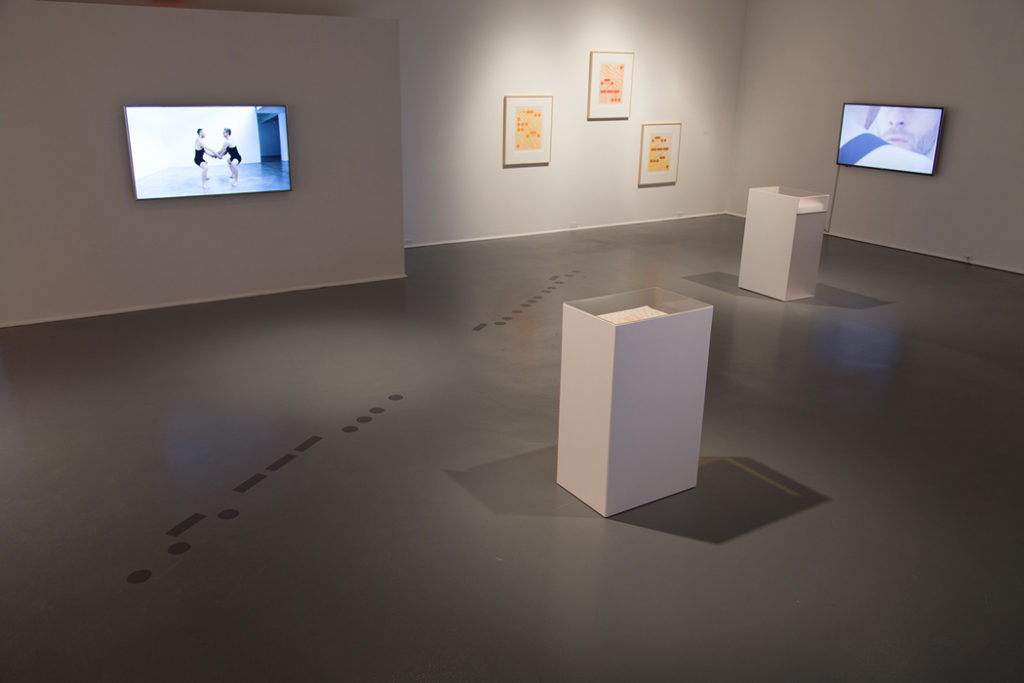Brendan Fernandes’s allusively titled exhibition, “They,” was named after his elegant, shadowy film referring to the “dance of queer cruising” on Fire Island, New York. In this recent show, the young Brooklyn-based Canadian staged a performance and presented several other works as dialogues about identity and love in our complex, globalizing world. Fernandes has regularly focused his video, sculpture and text projects on the subject of identity, though his earlier pieces typically addressed the specifics of race and ethnicity, rather than queerness.
His previous works often used his own experience as a Kenyan-born Indian who immigrated to Canada as a youth to humorously problematize the nature of authenticity. A particularly memorable performance video, Foe (2008), shows Fernandes training with a voice coach to learn (and often fail to learn) how to mimic the accented English spoken by an ostensible “real” Kenyan-born Indian, not one raised in the oral flatlands of suburban Toronto, as Fernandes was. The video laid out Fernandes’s artistic program, but this new exhibition showed him extending beyond that occasionally over-earnest frame to present a set of works that are no less politically astute, but also enlist the body to greater effect.
At the centre of the exhibition was an endurance performance and set of accompanying elements, entitled Encomium I, II, III (2013). Inspired by Plato’s “The Symposium,” it featured two male dancers garbed in wrestler’s tights executing precise mirrored poses dictated by the artist. The work was set within the older modern addition to the heritage house at Rodman Hall Art Centre. With its grey floor a few steps below grade, the house created the subtle suggestion of a forum environment. This perfectly accommodated a sense of “praxis” about the piece, with the action of the performers complemented by the reflection provided by Fernandes’s inclusion of poster multiples on Plexiglas plinths, and vinyl floor graphics. The take-away posters featured a script composed of lines invoking Plato’s writings (“The lover aims to teach his beloved”) and the artist’s directives concerning the dancers (“They relevé onto demi-pointe”).
The floor graphics employed the artist’s signature Morse code to designate the path traversed by the athletic pair, and cryptically displayed the words “love,” “Eros” and “desire,” spoken by Phaedrus in “The Symposium.” The entire situation had a quality of optimism about it—the dancers were healthy and agile and the plinths glowed brilliant orange and yellow, capped with the similarly vibrant posters. Here, Fernandes presented his Enconium (speech in praise of love), which resonates with the knowledge that Plato theorized the “ideal” form of love to be between males. So, in the piece, Fernandes made a robust declaration about love and queerness. Among this work’s other functions is the assertion that the art gallery can be used for presenting queerness in ways not often included among the many expressions of mourning and rage necessitated by the AIDS crisis. With “They,” the fact that the gallery was flooded with light and contained strong, lively bodies, was an insistence on a vigorous queer future.
Wry humour is part of Fernandes’s artistic toolkit, and it was not left idle here. Alongside all the thoughtful exuberance in Encomium I, II, III, the artist presented a video entitled seeing i (2014). This animation shows line drawings and rolling dialogue that reads like excerpts from a social media exchange between two elephants, one Asian and the other African. The work suggests the breakup of a gay relationship while also alluding to post-colonial power struggles. A series of handsome screenprints hung elsewhere in the gallery extended the imagery of the two elephants, with their profiles mirrored to resemble Rorschach inkblots. Fernandes has previously depicted animals in his works, but these elephants registered less as fraught ciphers for exoticism and otherness, and more as empathetic characters. Moreover, their extravagant trunks have such presence that the artist’s playful interest in likening the appendages to human-male protuberances is unavoidable. Yet there is more than coy eroticism here: the images of the heads of the giant and vulnerable creatures, well known for their emotionalism, gently conjoin in the prints to form curious, not quite heart-shaped love emblems.
In contemporary LGBT parlance, the word “they” is regularly used to replace the gendered pronouns “he” and “she.” Fernandes’s exhibition displayed a canniness that acknowledges such a politic. Meanwhile, it generously and engagingly invited viewers of any pronomial persuasion into the dialogues about love in the contemporary moment, thereby asserting that, at heart, “they” is all of us.









